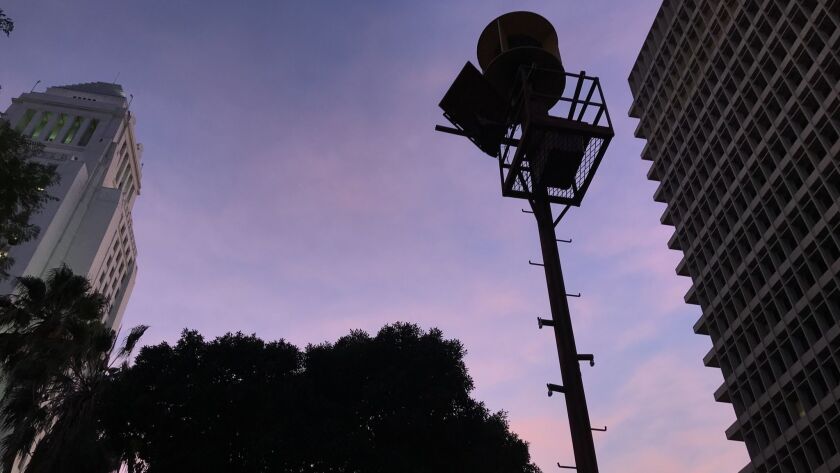Art Piece Called Seira Is Going to Be Played Over the Los Angeles Air Raid Siren System
It starts with an invisible chorus singing a ghostly note in the key of B-flat major. At first, the voices are barely recognizable above the din of downtown Los Angeles traffic during evening rush hour. Buses roar by. A skater scrapes to a full stop. Car horns squeal. But the note nonetheless hovers in the groundwork, a mellifluous ahhh that ultimately crescendos to a higher place the street dissonance as the sky turns purple and the lord's day slips behind the city's blinking towers.
This is "Seirá," an unusual vocal piece by Australian composer Lawrence English, performed not by a alive chorus on a stage (or even on the street) merely via the scattered air raid sirens that accept managed to survive in obscure corners of Los Angeles. It's part of this year's "AxS Festival: City as Wunderkammer" (or "cabinet of curiosities," as the organizers put it), a celebration of art and science presented by Fulcrum Arts (formerly the Pasadena Arts Council).
At sunset Friday, roughly ii dozen spectators are gathered for the premiere of "Seirá" at 1 of the sirens: a yellowish Federal Signal SD-ten at the corner of Bound and Temple streets near Metropolis Hall. It'south one of the half a dozen points effectually the city where the broadcasts can be heard. At 5:59 p.yard., correct as the sunday begins to gear up, barely perceptible tones emerge from the siren and bathe the corner in sound. At its base, the rapt crowd stands motionless.
English, who lives in Brisbane and travels regularly to Los Angeles for piece of work, says he start stumbled on i of the sirens about 5 years agone: a Federal Signal 500T — the sort that rotates — and he grew intrigued by their purpose.
"I thought it was strange," he says. "I went home and looked it up."
That initial bit of internet sleuthing turned into a bit of an obsession. On a subsequent trip, he visited the Los Angeles County archives to look at historical documents related to the sirens and their placement. He too located sound recordings that revealed their tones. (B-flat major, he notes, is a very close match.)
Fifty.A.'south civil defense sirens began every bit an air raid alarm system against Japanese aerial attacks during World State of war II. Merely their presence was expanded throughout the 1950s and '60s every bit the politics of the Cold War stoked paranoia over a possible Soviet missile set on. The last official test of sirens took place in the 1980s. Now they are disappearing.
"There is a rapid diminishing of the sirens," says English language. "I've spoken to people who take memory of it. But then many people do not."
The composer has preserved their retentiveness in the 12-minute "Seirá," which pays tribute to the sirens and the sounds they make. The piece, which English language recorded in Australia with the Brisbane choir Australian Voices, was inspired specifically past the wail of the500T siren. The shifting vocal tones in "Seirá" echo the changing tones of the 500T equally it rotates atop its pole.
Thanks to a grant from the Mike Kelley Foundation for the Arts and the sponsorship of Pasadena's Fulcrum Arts, the slice volition play on half a dozen Fifty.A. sirens every evening at sunset through Sunday. (It is not the showtime work of art to materialize on this emergency broadcast arrangement: Opera director Yuval Sharon employed the sirens for his staging of composer Annie Gosfield'due south "State of war of the Worlds" final twelvemonth.)
Amidst the clatter of traffic, "Seirá's" tranquillity beginnings come off near as an auditory hallucination — a sustained series of notes pause through the hiss of air brakes and automotive stereo systems. Merely equally it progresses, the sound builds, and the work becomes an ethereal soundtrack to random moments of urban life.
At Friday's broadcast, members of Pasadena's Selah Gospel Choir infiltrate the crowd, and several minutes into the recording, they begin to echo the tones emanating from the siren. As the L.A. sky puts on its best sunset bear witness, our group is bathed past voices emanating from higher up and all around. When information technology comes to an terminate, the oversupply erupts in joyful applause.
Employing old regime hardware in the name of art? I can't retrieve of a meliorate use.

Lawrence English's composition, titled "Seirá," volition be played every twenty-four hour period at sunset through Nov. 11.
(Carolina A. Miranda / Los Angeles Times)
AxS Festival 2018: Lawrence English, "Seirá"
When: Every evening at dusk through November. 11
Where: Six ceremonious defense siren sites around Los Angeles
Info: Bank check the website for exact start times and locations, axsfestival.org/lawrence-english
ALSO
'War of the Worlds': Febrile opera rises from the decease and destruction of 50.A.
Review: Los Angeles Opera'due south 'Satyagraha' lives up to Gandhi'southward ideals
Westwood's Crest Theater to be reborn as UCLA Nimoy Theater, an experimental performance space
In advance of the midterms, Barbara Kruger reprises MOCA mural that asks 'Who is across the law?'
Sign up for our weekly Essential Arts & Culture newsletter »
carolina.miranda@latimes.com | Twitter: @cmonstah
Source: https://www.latimes.com/entertainment/arts/miranda/la-et-cam-lawrence-english-air-raid-siren-concert-20181107-story.html
Post a Comment for "Art Piece Called Seira Is Going to Be Played Over the Los Angeles Air Raid Siren System"